10 Muscle Moves to Help Tame Diabetes
Why Do Strength Training?
If you have diabetes, you know the importance of controlling your blood sugar. But did you know that strength training can play a starring role? Simple moves done regularly can prompt your muscles to absorb more sugar. You'll also burn more calories around the clock when you take up strength training. Your mood, cholesterol levels, and blood pressure may improve, too.

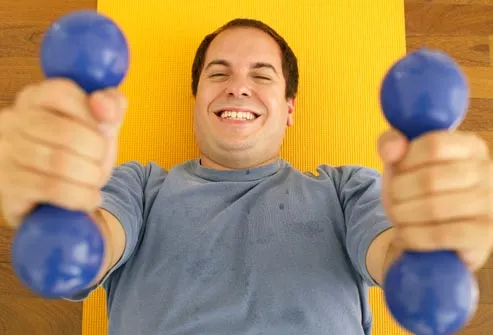
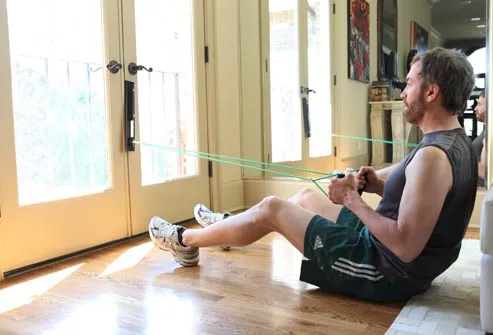
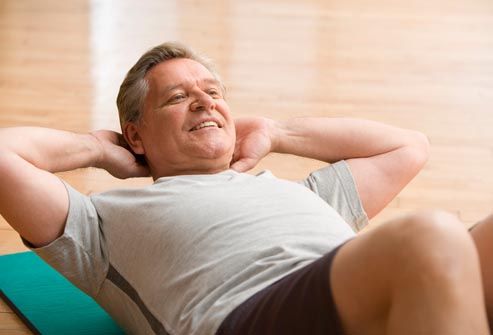
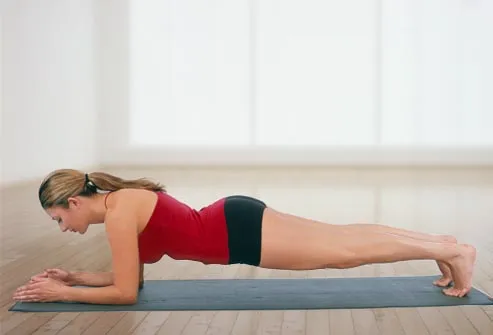
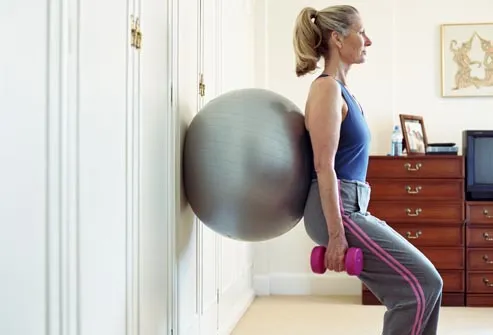
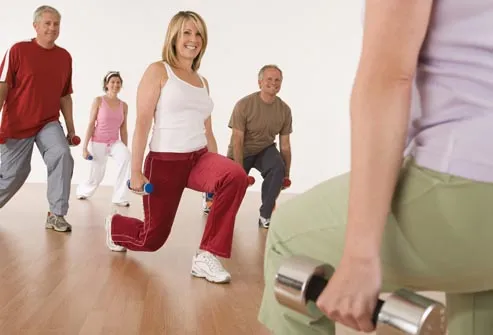
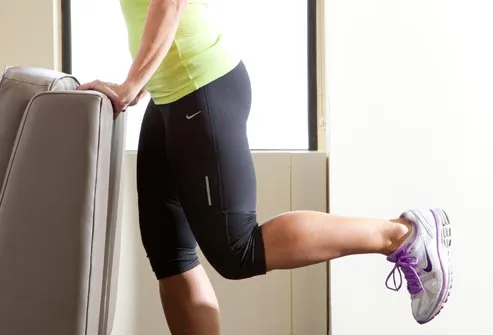
http://gseasyrecipes.blogspot.com/
for info about knee replacement, you can view my blog-
http://Knee replacement-stick club.blogspot.com/
for crochet designs
http://My Crochet Creations.blogspot.com
If you have diabetes, you know the importance of controlling your blood sugar. But did you know that strength training can play a starring role? Simple moves done regularly can prompt your muscles to absorb more sugar. You'll also burn more calories around the clock when you take up strength training. Your mood, cholesterol levels, and blood pressure may improve, too.
Beginning an Exercise Program
Most people with diabetes can work out safely, but check with your doctor first. You should aim for strength training at least twice a week and regular cardio, either five days a week for 30 minutes, or three days for 50 minutes. Always exercise caution, and if a move doesn't feel right, check with a fitness expert. Flexibility work can be helpful, too, especially if you haven't broken a sweat in a while.
Your Strength Training Routine
Get ready to learn 10 at-home exercises that work your major muscle groups. For each one, begin with one set of 10-15 reps. Rest 30-120 seconds before the next move. Start with resistance bands or light dumbbells that allow you to focus on form. When you can do two or three sets easily, grab heavier weights. You should eventually use weights that you can only lift 8-10 times in the first set.
Upper Body: Standing Biceps Curl
Grab a dumbbell in each hand and stand with your palms facing your thighs. Squeeze your biceps as you lift the weights. On the way up, your forearm should rotate so your palms end up facing your shoulders at the top. Lower the weights slowly to starting position. Try to avoid using momentum on the way down.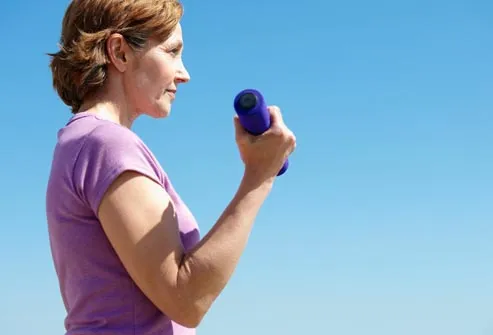

Upper Body: Triceps Extension
Stand with one foot slightly in front of the other, and hold a single dumbbell with both hands wrapped around the handle. Slowly raise the dumbbell overhead. Straighten your elbows as you raise the weight toward the ceiling. Slowly bend your elbows and lower the weight behind your head. Keep your upper arms still and vertical to the floor. Keep your shoulder blades down and back as you repeat.

Upper Body: Shoulder Press
You can do the shoulder press while sitting or standing. Hold a dumbbell in each hand and raise them until they are level with your ears. Your elbows should be bent at a 90-degree angle. This is your starting position. Now push the weights up, until your arms are fully extended. Slowly lower to the starting position.

Upper Body: Chest Press
Lie on your back with your knees bent and your feet flat on the floor. Hold a dumbbell in each hand at chest level and raise them above your chest until your elbows are straight but not locked. Pause a second and then slowly lower the weights toward your chest.

Upper Body: Seated Row
Sit on the floor with your feet together and your knees bent. Hold a dumbbell or the end of a resistance band in each hand with your arms straight in front of you, palms facing each other. Keeping your back straight, bend the elbows as you pull the weights/bands to your sides. Keep your elbows close to your body and slowly straighten your arms.

Classic Crunch
Lie on your back, feet flat on the floor, knees bent. Put your hands behind your head. Pull your shoulder blades together and your elbows back. The elbows should aim sideways and stay there throughout the exercise. Squeeze the abs and curl your shoulders and upper back off the floor. Lower down slowly, keeping your lower back pressed to the floor at all times.

Plank
Lie face-down with your elbows directly under your shoulders, palms down, and your toes tucked under. From this starting position, tighten your abs as you lift your torso and thighs off the floor. You'll be supported only by your toes and forearms. Hold this position for 5 seconds or more. Keep the back straight as you slowly lower to the starting position

Lower Body: Squat
Stand with your feet shoulder-width apart. Bend your knees and lower yourself as if you were sitting in an imaginary chair. Your thighs should be parallel to the ground and your knees should not push forward past your toes. Lean forward slightly as you stand back up. You can also do squats while leaning against a stability ball placed between your back and a wall.

Lower Body: Lunges
Stand with your legs shoulder-width apart and step your right leg back, bending the knee toward the floor without allowing it to touch. Your left thigh should be nearly parallel with the floor. Press down on the left heel and bring the right leg back to a neutral stance. Do 8-12 reps and then change sides, stepping back on the left leg. To make the lunges more challenging, hold a dumbbell in each hand.

Lower Body: Hamstring Curl
Hold onto the back of a chair. Flex your left foot and bend the knee, bringing your heel toward your buttocks. Keep your right leg slightly bent. Lower your left foot back to the floor. Do 8-12 reps and then repeat with the right leg. To make this exercise more challenging, ask your doctor if it is safe for you to wear ankle weights.

Strength Training and Blood Sugar
If you take certain diabetes medications, you may need to take precautions to avoid a dangerous drop in blood sugar (hypoglycemia). Ask your doctor if you should check your blood sugar or eat a snack before working out. Keep snacks or glucose tablets with you when you're exercising in case you develop symptoms of low blood sugar, such as shaking or weakness.
Strength Training and Insulin
If you take insulin, you may need to adjust the dose before and after exercise. Begin with a gentle workout to see how it affects your blood sugar. Check your levels before, during, and after exercise. If you work out within an hour or two of a meal, you may need to reduce your meal-time insulin dose. Check with your doctor before making any insulin changes. Oral diabetes medicines may also need to be lowered when you exercise.
Who Should Not Lift Weights?
Weight-lifting is not recommended for people with diabetes-related eye problems (such as retinopathy) that are not being treated. Likewise, very intense cardio work is not a good idea with untreated retinopathy. Both can increase pressure in the eyes. If you have nerve damage in your feet, sitting or lying on the floor may be a better bet. Remember, check with your doctor before beginning a fitness program.
ps- this is only for information, always consult you physician before having any particular food/ medication/exercise/other remedies.
ps- those interested in recipes are free to view my blog-
http://gseasyrecipes.blogspot.com/
for info about knee replacement, you can view my blog-
http://Knee replacement-stick club.blogspot.com/
for crochet designs
http://My Crochet Creations.blogspot.com
Labels: biceps, blood sugar, chest, diabetes, Exercise, eyes, hamstring, insulin, lifting weights, press, pressure, retinopathy, shoulders, strength, training, triceps

0 Comments:
Post a Comment
<< Home